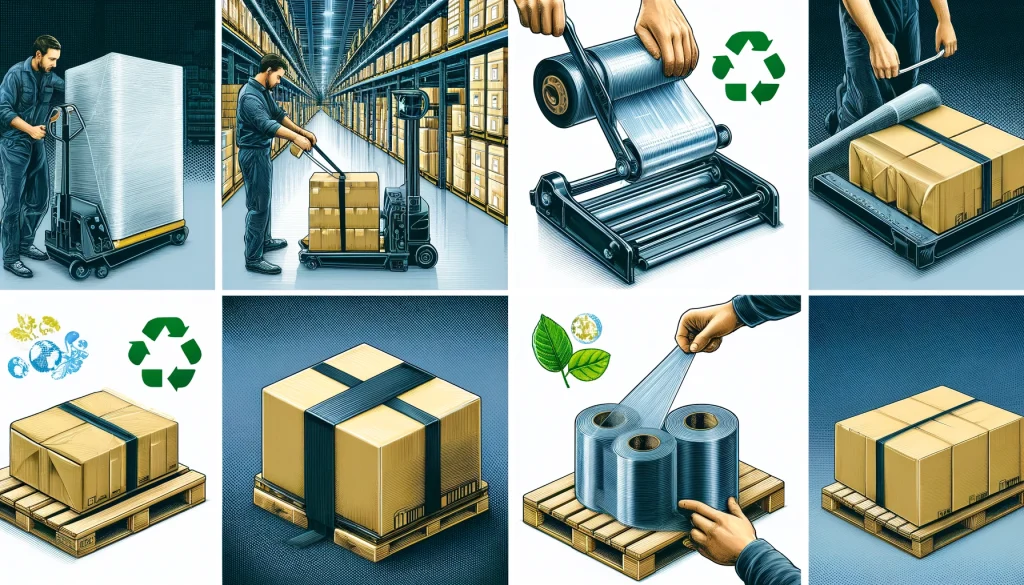Introduction
Stretchwrap, also known as stretch film, is a vital component in the packaging and shipping industry. Its versatility, strength, and cost-effectiveness make it indispensable for businesses of all sizes. This blog post explores the various types of stretchwrap, its applications, and the latest innovations that are making it even more efficient and environmentally friendly.
What is Stretchwrap?
Stretchwrap is a plastic film that is highly stretchable and is used to wrap products together on a pallet. The elasticity of the film ensures that the load is tightly bound and protected during transport and storage. It is commonly made from linear low-density polyethylene (LLDPE) due to its superior stretchability and strength.
Types of Stretchwrap
Hand Stretchwrap
Hand stretchwrap is designed to be applied manually. It is ideal for small-scale operations or businesses that do not require high volumes of wrapping. Hand stretchwrap is available in various thicknesses and widths, allowing for customization based on the specific needs of the products being wrapped.
Machine Stretchwrap
Machine stretchwrap is used with wrapping machines, making it suitable for larger operations with high-volume packaging needs. This type of stretchwrap is more efficient and consistent compared to hand wrapping. There are several types of machine stretchwrap, including:
- Pre-Stretched Film: Pre-stretched film has been stretched during the manufacturing process, making it easier to apply and reducing the amount of effort needed to achieve a tight wrap.
- Blown Stretchwrap: This film is created by blowing heated resin into a bubble and then cooling it. It offers superior puncture resistance and is ideal for heavy or irregular loads.
- Cast Stretchwrap: Produced by feeding a sheet of molten plastic through cooled rollers, cast stretchwrap provides excellent clarity, making it easier to inspect wrapped products.
Applications of Stretchwrap
Securing Pallet Loads
One of the primary uses of stretchwrap is securing products on pallets for transport. It ensures that the items remain in place and are protected from dust, dirt, and moisture. This is crucial for maintaining the integrity of the products during long journeys and handling.
Bundling Smaller Items
Stretchwrap is also used to bundle smaller items together, making them easier to handle and store. For instance, multiple boxes or products can be wrapped together to create a single, manageable unit. This application is common in retail and warehouse settings.
Protecting Products
Stretchwrap provides an additional layer of protection against environmental factors. It can shield products from UV rays, dust, and moisture, ensuring they reach their destination in pristine condition. Some stretchwraps come with UV inhibitors or are colored to offer enhanced protection against sunlight.
Innovations in Stretchwrap
Eco-Friendly Stretchwrap
With the increasing focus on sustainability, the packaging industry is innovating to create more environmentally friendly options. Eco-friendly stretchwraps are made from recycled materials and are designed to be recyclable themselves. These films maintain the same level of performance as traditional stretchwraps while reducing environmental impact.
High-Performance Films
Recent advancements have led to the development of high-performance stretchwraps that offer greater strength and stretchability with less material. These films reduce waste and cost while providing superior load stability. They are particularly beneficial for companies looking to optimize their packaging processes and reduce their carbon footprint.
Stretchwrap Dispensers and Machines
The introduction of advanced stretchwrap dispensers and wrapping machines has significantly improved the efficiency and consistency of applying stretchwrap. These machines can pre-stretch the film to maximize its potential, reduce manual labor, and minimize film usage. Some machines are equipped with sensors and automated systems that adjust the wrapping process based on the size and shape of the load.
Best Practices for Using Stretchwrap
Choosing the Right Stretchwrap
Selecting the appropriate type of stretchwrap is crucial for ensuring the safety and stability of your products. Consider factors such as the weight, shape, and size of the items being wrapped, as well as the environmental conditions they will be exposed to during transport and storage.
Proper Application Techniques
Whether using hand or machine stretchwrap, proper application techniques are essential for achieving optimal results. Ensure that the film is applied with consistent tension and that the load is evenly wrapped. Overlapping the film layers and securing the ends can enhance stability and protection.
Regular Maintenance of Equipment
For businesses using machine stretchwrap, regular maintenance of the wrapping equipment is vital. Ensure that the machines are properly calibrated and that the rollers, sensors, and other components are in good working condition. This helps maintain the efficiency and effectiveness of the wrapping process.
Conclusion
Stretchwrap is an indispensable tool in the packaging and shipping industry, offering versatility, protection, and cost-effectiveness. With advancements in eco-friendly materials and high-performance films, stretchwrap continues to evolve, meeting the demands of modern businesses and sustainability goals. By choosing the right type of stretchwrap and employing best practices, companies can enhance their packaging processes, protect their products, and contribute to a more sustainable future.
Call to Action
If you’re looking to improve your packaging and shipping operations, consider investing in high-quality stretchwrap and the latest wrapping equipment. Stay informed about new innovations in the industry and continually seek ways to optimize your processes. Together, we can enhance the efficiency and sustainability of packaging solutions, ensuring a brighter future for our businesses and the environment.


